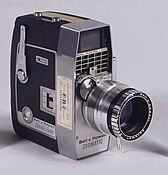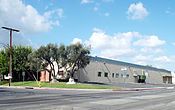Bell & Howell
This article needs additional citations for verification. (August 2007) |
 Original headquarters in Chicago | |
| Company type | Brand |
|---|---|
| Industry | Cameras, lenses, and motion picture machinery |
| Founded | February 17, 1907 in Chicago, Illinois |
| Founder | Albert S. Howell |
| Headquarters | , United States |
| Website | www |
Bell and Howell is a United States brand of cameras, lenses, and motion picture machinery. It was originally founded as a company in 1907, and headquartered in Wheeling, Illinois. The company was acquired by Böwe Systec in 2003. Since 2010, the brand name has been licensed for a variety of consumer electronics products.
History
[edit]

According to its charter, the Bell & Howell Company was incorporated on February 17, 1907. It was recorded in the Cook County Record Book eight days later. The first meeting of stockholders took place in the office of Attorney W. G. Strong on February 19 at 10 a.m. (10:00 CT). The first board of directors was chosen for a term of one year: Donald Joseph Bell (1869–1934), chairman; Albert Summers Howell (1879–1951), secretary; and Marguerite V. Bell (wife of Donald Bell), vice chairman.[1]
The firm made products for the motion picture industry. The Bell & Howell 2709 was the first all metal, commercially available motion picture camera. [citation needed][2] The 2709 was so expensive that only Charlie Chaplin and three other people owned one,[3] while the rest were owned by studios.
Bell & Howell introduced products that improved the quality of projected images in a movie theater. The Kinodrome 35-mm projector mechanism, introduced in 1907, steadied projected images and reduced the flicker that can occur during motion-picture projection.[4] The 35-mm perforator, introduced in 1910, set the standard throughout the industry as to the expected distance and width of the sprocket holes running on each side of the 35-mm film; before this there had been no agreed upon standard[5]
Bell & Howell developed a continuous film printing process in 1911, that was gradually accepted across the film printing industry.[6][7]
Historically, Bell & Howell Co. was an important supplier of many different media technologies, and it produced products such as:
- Newsreel and amateur film cameras such as the Filmo (end of 1923) and Eyemo (1925), and Autoload EE (1956)
- Military Gun sight TYPE N-8[8]
- Regular-8 and Super-8 film cameras and projectors (all models)
- 16mm silent and sound projectors (all models)
- Slide projectors (2" × 2"; 5 cm x 5 cm)
- 35mm filmstrip projectors
- Overhead presentation projectors (all models)
- Stereo cameras and stereo slide projectors through its TDC subsidiary
- Slide Cube Projector, circa 1970
In 1934, Bell & Howell introduced their first amateur 8mm movie projector, in 1935 the Filmo Straight Eight camera, and in 1936 the Double-Run Filmo 8. The 1938 Kodak cassette holding 25 feet (7.6 m) of Double-Eight film was taken by the Filmo Auto-8 in 1940.[citation needed]
The firm added microfilm products in 1946. In 1954, Bell & Howell purchased DeVry Industries' 16mm division.[9]
Although known for manufacturing their film projectors, a partnership with Canon between 1961 and 1976 offered still cameras. Many of their 35mm SLR cameras were manufactured by Canon with the Bell & Howell logo or Bell & Howell/Canon in place of the Canon branding. The firm dropped the production of movie cameras by the end of the 1970s.[citation needed]
Bell & Howell was a supplier of media equipment for schools and offices. The film laboratory line is now a separate company, BHP Inc, which is a division of Research Technology International.[citation needed]
In 1960, Bell & Howell merged with an Electronics and Instrumentation company CEC, Lennox Road, Basingstoke, UK. This facility produced pressure transducers and other devices for applications in areas such as North Sea oil platforms, the chemical industry, and the Ariane Space vehicles.[10] This division was divested to Transamerica Corporation in 1983.[11]
In 1977, Bell & Howell signed an agreement with BASF to develop a new amateur videotape recorder, which would have made use of a 6.25 millimetres (0.246 in) tape on which 28 of parallel tracks were to be recorded with the aid of a fixed head. The machine was expected to be ready by Christmas 1979,[12][13] but did not reach the market.

Bell & Howell purchased University Microfilms International in the 1980s. UMI produced a product called ProQuest.
In the 2000s, Bell & Howell decided to focus on their information technology businesses. The imaging business was sold to Eastman Kodak, and the international mail business was sold to Pitney Bowes. On June 6, 2001, Bell & Howell became a ProQuest Company,[14] which was then a publicly traded company, but is now a subsidiary of the private Cambridge Information Group. In September 2001, the remaining industrial businesses along with the Bell & Howell name were sold to private equity firm Glencoe Capital.[citation needed]
The company merged with the North American arm of Böwe Systec Inc.[when?] Later, in 2003, Böwe Systec acquired the entire company. The company was known as Böwe Bell & Howell until 2011, when Versa Capital Management bought the company out of bankruptcy and renamed the company "Bell and Howell, LLC".[15]
In 2010 consumer electronics manufacturer Elite Brands licensed the Bell + Howell brand name to use on optical and imaging products including digital cameras and camcorders, binoculars, telescopes, lenses, and various camera accessories.[16] BHH, LLC has also expanded licensing of the Bell + Howell brand name for a range of products including lighting and security, personal care, tools, pest control, auto accessories and luggage.[17][18]
In 2011 a digital video recorder was released featuring the Bell + Howell brand.[19]
In 2017 the company spun off the mail sorting business, including vote by mail, to Fluence Automation,[20] which was then acquired by BlueCrest Inc. in 2021.[21] BlueCrest had acquired the Pitney-Bowes document messaging business in 2018.[22]
In December 2018, Versa Capital Management, LLC ("Versa") announced the successful closing of the sale of Bell and Howell to Boston-based WestView Capital Partners ("WestView").[citation needed]
Apple II
[edit]Bell & Howell marketed a specially designed Apple II Plus computer to the educational market beginning in July 1979. The modified Apple had additional security elements for classroom use such as a tamper-proof cover. The case color was black but the inside was a standard Apple II Plus.[23][24] The modified Apple II became known colloquially among computer enthusiasts as the "Darth Vader" Apple II for its black case design.[25]
Education Group
[edit]Bell & Howell founded an Education Group within the company in 1907. This Education Group created Bell & Howell Schools in 1966. In that same year, the Education Group purchased a controlling share of DeVry Institute of Technology. Two years later in 1968, Bell & Howell's Education Group, via a controlling interest in DeVry, acquired Ohio Institute of Technology in Columbus, Ohio.[26] Over the years, the Education Group has bought and sold large interests in a variety of educational organizations and institutions, including Heathkit which supplied electronics kits for Bell & Howell courses.
Gallery
[edit]-
Specimen stock certificate
-
8mm Movie Camera with Electric Eye
-
Bell & Howell 8mm amateur camera Filmo Straight Eight
-
Bell & Howell Zoomatic movie camera used to shoot the Zapruder film, in the collection of the U.S. National Archives
-
Bell & Howell 8mm home movie camera, model Two Twenty
-
Bell & Howell 200 Movie Camera
-
Bell & Howell Autoload 309 Super 8 Camera
-
Educational version of Apple II computer
-
Bell & Howell's former western United States regional headquarters at 623 Circle Seven Drive (formerly 623 Rodier Drive) in Glendale, California
See also
[edit]- Charles H. Percy
- BH Film perforation
- TeleMation Inc. In 1977, TeleMation inc. became a division of Bell and Howell.
- Pocket comparator
- Gordon Bradt
References
[edit]Notes
- ^ Aldred, John (October 2007). "Donald J. Bell 1869-1934 and Albert S. Howell 1879-1951". Image Technology. 89 (4): 16.
- ^ Williams, David (2019). "Tools of the Trade". American Cinematographer. 100 (12): 92–98 – via Art Full Text.
- ^ James, Grahame. "For Sale: Charlie Chaplin's Movie Camera". Retro Thing. Retrieved 2019-11-17.
- ^ Ehrenberg, John; Roberts, Laurence (1983). "Seventy-five years of motion-picture standards: Contributions of Bell & Howell Co". SMPTE Journal. 92 (10): 1058–1063. doi:10.5594/J04133.
- ^ Roberts, Laurence. "Cameras and systems: A history of contributions from the Bell & Howell Co". SMPTE Journal. 91 (10): 934–946. doi:10.5594/J00229.
- ^ Kattelle, Alan (2000). Home movies: A history of the American industry, 1897-1979. New Hampshire: Transition Publishing.
- ^ Richard Abel, ed. (2004). Encyclopedia of Early Cinema. Taylor & Francis. p. 240. ISBN 9781134566754.
- ^ "American Fixed and Free-Mounted Gunsights used by the RAF - Axis History Forum". forum.axishistory.com. Retrieved 2022-08-28.
- ^ "DeVry Movie Projector Production Flickers Out". Chicago Tribune. Nov 4, 1965. Retrieved 2017-07-17.
- ^ "Senior Process Engineer (advertisement)". New Scientist. 96 (1326): 64. October 7, 1982. ISSN 0262-4079. Retrieved 2017-03-16.
- ^ "Company History : CEC Vibration Products". www.cecvp.com.
- ^ "Bell & Howell Plans New Video Recorder". The New York Times. 1977-01-09. Retrieved 2022-09-12.
- ^ "Technology section". New Scientist: 298. 4 August 1977. Retrieved 2022-09-13.
- ^ Paula J. Hane (2001-06-11). "Bell & Howell Becomes ProQuest Company". Newsbreaks.infotoday.com. Retrieved 2014-08-16.
- ^ Judge OKs $80M Versa Bid For Bowe Bell & Howell
- ^ James, Grahame (August 11, 2010). "Elite Brands to License Bell + Howell". Digital Imaging Reporter. Retrieved 2022-01-06.
- ^ "Bell + Howell Expands Offerings". License Global. April 6, 2018. Retrieved 2022-01-06.
- ^ "About Us — Emson". E. Mishan & Sons, Inc. Retrieved 2022-01-06.
- ^ "Bell and Howell T100HD-R Repair". iFixit.
- ^ "Bell and Howell Sells Sorting Business to Fluence Automation". Bell and Howell. 2017-08-01. Retrieved 2022-11-11.
- ^ "Fluence Automation acquired by BlueCrest". Parcel and Postal Technology International. 2021-11-04. Retrieved 2022-11-11.
- ^ "Pitney Bowes DMt is now BlueCrest". www.bluecrestinc.com. 2018-07-24. Retrieved 2022-11-11.
- ^ "Apple and Bell & Howell Enter Education Market". Intelligent Machines Journal. 1 (11). InfoWorld Media Group: 77. July 18, 1979. ISSN 0199-6649.
- ^ "Apple II Plus - Bell & Howell Model – Introduction". The Mac Geek. Pearl City Networks. 2010. Retrieved August 1, 2013.
- ^ "6-The Apple II Plus". Apple2history.org. 2008-12-03. Retrieved 2019-11-17.
- ^ Page six of the Ohio Institute of Technology Student hand book from the school year 1974-1975
Bibliography
- "Unlocking the Vault". Forbes. Dated November 13, 2000, viewed December 7, 2006
- BHP Inc Website viewed December 7, 2006
- "Versa Capital Management Completes Successful Sale of Bell and Howell" (Press release). Businesswire. December 4, 2018.
External links
[edit]- Official website
- European & International Sector. (Wayback Machine copy)
- The Zapruder Camera Bell & Howell 414PD Director Series - Overview and User's Manual. (Wayback Machine copy)
- Bell & Howell at Made in Chicago Museum
- Photography companies of the United States
- Organizations awarded an Academy Honorary Award
- Electronics companies established in 1907
- Companies based in Cook County, Illinois
- Movie cameras
- Movie camera manufacturers
- 1907 establishments in Illinois
- Academy Award for Technical Achievement winners
- Defunct computer hardware companies
- Defunct computer systems companies









